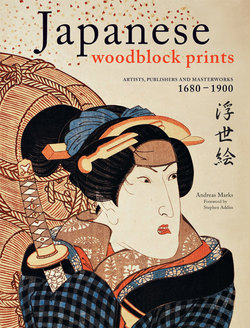Читать книгу Japanese Woodblock Prints - Andreas Marks - Страница 35
ОглавлениеHokusai
1760?–1849
Family name: Kawamura, Nakajima (adopted). Child name: Tokitarō. Given name: Tetsuzō. Art surnames: Katsukawa, Katsushika. Artist names: Shunrō, Sōri, Hokusai, Taitō, Iitsu, Manji. Art names: Gunbatei, Kakō, Tokimasa, Gakyōjin, Gakyō Rōjin et al.
Hokusai arguably the most famous Japanese artist. Born in 1760, he was initially trained as a carver of woodblocks and only at the age of eighteen began to learn how to design prints from Katsukawa Shunshō. It is said that he studied with Kanō Yūsen Hironobu (1778–1815), Tsutsumi Tōrin III (active c.1790s–1830s), Sumiyoshi Hiroyuki (1755–1811) and others. Hokusai frequently changed his art name, using more than thirty different names. His earliest work, signed Katsukawa Shunrō, is an actor print dating from 1778. During the period when he used the name Shunrō, he mostly designed prints in relation to the kabuki theater, but soon turned to landscapes and historical prints. In 1795, he took over the Tawaraya painting studio and changed his name to Sōri. He started to use the name Hokusai in 1797 and in 1805 the art surname Katsushika. He continued to be active until his death in 1849, thus having the longest career of any Japanese print artist.
Over a period of more than seventy years, Hokusai created several thousand highly original prints, paintings, sketches, and book illustrations. He worked for over thirty different publishers—most importantly Iseya Rihei, Moriya Jihei, and Nishimuraya Yohachi. He became most famous for his Western-style prints and landscapes, a genre that he significantly influenced. Amongst his most renowned works are his series illustrating life along the Tōkaidō road that connected Edo (present-day Tokyo) with Kyoto, published from c. 1802 until 1810. Also celebrated were his series of sketch books, Hokusai manga, published in fifteen volumes from 1814 until 1878. Equally popular were his pictures of Mount Fuji, especially the series “Thirty-six Views of Mount Fuji” (Fugaku sanjūrokkei) published from c.1829-33, and the book “One Hundred Views of Mount Fuji” (Fugaku hyakkei) published from 1834–35. Widely known is his picture of Mount Fuji Behind the Wave offKanagawa (Kanagawa oki, nami ura), commonly referred to as “ The Great Wave,” from the series “Thirty-six Views of Mount Fuji.”
Hokusai seemed to have been rather eccentric and moved houses over ninety times. He had several students; amongst the most talented were Hokkei and Hokuba (1771–1844). Hokusai died at the advanced age of 90 on the eighteenth day of the fourth month in 1849. His posthumous name is Nanshōin Kiyo Hokusai Shinji.
c.1829–33 “Ejiri in Suruga Province” (Sunshū Ejiri), from the series “Thirty-six Views of Mount Fuji” (Fugaku sanjūrokkei) ōban. Publisher : Nishimuraya Yohachi Library of Congress Nagata 1981, p. 229, vertical ōban no. 18.35
C.1829–33. “In the mountains of Tōtōmi Province” (Tōtōmi sanchū), from the series “Thirty-six Views of Mount Fuji” (Fugaku sanjūrokkei) ōban. Publisher : Nishimuraya Yohachi Collection Peter Reider. Ref.: Nagata 1981, p. 229, vertical ōban no. 18.38
C.1810. "Shōno,” from a series known as “Tōkaidō published in the year Bunka 7 (1810)” (Bunka schichinen ban Tōkaidō) 11.4 x 11.8 cm (4.5 x 4.6 in.) Publisher : Tsuruya Kinsuke Library of Congress Ref.: Nagata 1981, p. 225, vertical koban no. 4.46
c.1829–33 “Snowy morning at Koishikawa” (Koishikawa yuki no ashita), from the series “Thirty-six Views of Mount Fuji” (Fugaku sanjūrokkei). ōban. Publisher: Nishimuraya Yohachi. Library of Congress. Nagata 1981, p. 229, vertical ōban no. 18.11.
c.1831 “Cat’s love” (Neko no koi), from an untitled series of caricatures with poems. Chūban. Publisher: Moriya Jihei. Collection Erich Gross, Switzerland. Nagata 1981, p. 227, chūban no. 24.3.
c.1830 “Laughing demoness” (Warai hannya), from the series “One Hundred Ghost Stories” (Hyaku monogatari). Chūban. Publisher: Tsuruya Kiemon. Collection Peter Rieder. Nagata 1981, p. 227, chūban no. 25.1.
c.1830–33 “South wind, clear sky” (Gaifū kaisei), also known as “Red Fuji”, from the series “Thirty-six Views of Mount Fuji” (Fugaku sanjūrokkei). ōban. Publisher: Nishimuraya Yohachi. Honolulu Academy of Arts: Gift of James A. Michener, 1970 (15583). Nagata 1981, p. 229, vertical ōban no. 18.33.
1800s "Returning Sails at Yabashi” (Yabashi no kihan), from the series “New Edition of the Eight Views of ōmi” (Shinpan ōmi hakkei). Chūban. Library of Congress. Nagata 1981, p. 227, chūban no. 15.2.
